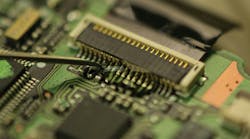The BMBF-funded project IMAGE for the development of innovative printable electrode materials for high-efficient organic light-emitting diodes and solar cells has been successfully completed.
Dresden: Progress in the development of flexible, transparent electrodes for OLED, OPD and OPV. After a term of 3 years, the jointly funded project IMAGE (innovation printable electrode materials for high performance lighting devices and organic solar cells “IMAGE”) has been successfully completed by the Federal Ministry of Education and Research and the French Agence Nationale de la Recherche. As a result, the project partners Carnot MIB from Bordeaux (project leaded by LCPO) and Fraunhofer COMEDD from Dresden demonstrated novel transparent electrodes, which are arranged on a backing film and enable flexible electronic components. The performance of these electrodes, which are made up of organic materials, was demonstrated by using flexible OLED and organic solar cells. The objective of the project IMAGE was the development of innovative printable, transparent electrode materials for high-efficiency organic light-emitting diodes and solar cells. This should be cost-effective, conductive, transparent, flexible, compatible and capable of being integrated in OLED or organic solar cells. The electrodes developed in IMAGE should replace conventional transparent metal oxides, such as indium tin oxide (ITO), which are less flexible and less cost effective.
Dr. Olaf R. Hild, business unit manager at Fraunhofer COMEDD, explains the significant results as follows:
"We were able to construct the electrodes very thin, transparent and flexible and to integrate them in our processes. Thus Fraunhofer COMEDD is now in a position to manufacture flexible organic devices such as OLED lighting films, organic solar cells or sensors on film according to customer requirements.
Technical results at a glance:
- PEDOT-based electrodes, PSS free
- Transparency @ 550 nm up to 85 %
- Layer Resistance: 90 ohms/sq.
- Conductivity: 200 Scm-1
- Integration on PET foils and PET foils with barrier films
- Laser-structurable
- OLED/OPV compatible
- Improved rolling capacity compared to ITO-based electrodes
Subsequent to the promising results of the project IMAGE, the consortium is now looking for industry partners for commercialization. Especially film manufacturers and film refiner can take thisopportunity to cooperate with material developers in order to make flexible transparent and conductive film products for numerous applications, e. g. in the field of photovoltaic, organic electronics or for touchscreens, ready for the market.
The IMAGE consortium:
The partners from MIB were responsible for the development of suitable chemical compositions and solutions for the production of transparent organic electrodes. Fraunhofer COMEDD developed the structuring procedures and integrated OLED and organic solar cells in the novel electrodes and developed encapsulation technologies. The companies Arkema and Tridonic provided advisory support to the project consortium during the project duration.
Carnot MIB institute (University of Bordeaux, FRANCE):
Leader: LCPO (Laboratoire de Chimie des Polymères Organiques);
Principal coordinator: Prof. Georges Hadziioannou ([email protected])
IMS (Laboratoire de l’Intégration du Matériau au Système)
CRPP (Centre de Recherche Paul Pascal)
This project was funded by the German Federal Ministry of Education and Research and the Agence Nationale de la Recherche in joint program "Inter Carnot Fraunhofer".
Many thanks to the funding agency and all partners.
About Fraunhofer COMEDD:
Fraunhofer COMEDD was founded as a research institution of the Fraunhofer-Gesellschaft in order to transfer the results of research and development in the field of organic materials and systems to production. The institution combines research and development works for the production, integration and technology of organic electronic devices. The focus of Fraunhofer COMEDD lies in customer- and application orientated research, development and pilot fabrication of novel module concepts and fabrication methods for these organic electronic devices. Fraunhofer COMEDD is an European-wide leading production-related research and development center for organic semiconductors focusing on organic light-emitting diodes and vacuum technology. The Fraunhofer COMEDD clean room consists of the following equipment:
- a pilot line for the fabrication of OLEDs on 370 x 470 mm2 substrates,
- two pilot lines for 200 mm wafer for the OLED integration on silicon substrates as well as
- a research line for the roll-to-roll fabrication on flexible substrates.
Fraunhofer COMEDD offers a wide range of research, development and pilot production possibilities, especially for OLED lighting, organic solar cells and OLED microdisplays. After the Fraunhofer-Gesellschaft has decided to consolidate its key competences in Dresden Fraunhofer Institute for Electron Beam and Plasma Technology FEP and Fraunhofer COMEDD now started the integration of both institutions.
Dresden: Progress in the development of flexible, transparent electrodes for OLED, OPD and OPV. After a term of 3 years, the jointly funded project IMAGE (innovation printable electrode materials for high performance lighting devices and organic solar cells “IMAGE”) has been successfully completed by the Federal Ministry of Education and Research and the French Agence Nationale de la Recherche. As a result, the project partners Carnot MIB from Bordeaux (project leaded by LCPO) and Fraunhofer COMEDD from Dresden demonstrated novel transparent electrodes, which are arranged on a backing film and enable flexible electronic components. The performance of these electrodes, which are made up of organic materials, was demonstrated by using flexible OLED and organic solar cells. The objective of the project IMAGE was the development of innovative printable, transparent electrode materials for high-efficiency organic light-emitting diodes and solar cells. This should be cost-effective, conductive, transparent, flexible, compatible and capable of being integrated in OLED or organic solar cells. The electrodes developed in IMAGE should replace conventional transparent metal oxides, such as indium tin oxide (ITO), which are less flexible and less cost effective.
Dr. Olaf R. Hild, business unit manager at Fraunhofer COMEDD, explains the significant results as follows:
"We were able to construct the electrodes very thin, transparent and flexible and to integrate them in our processes. Thus Fraunhofer COMEDD is now in a position to manufacture flexible organic devices such as OLED lighting films, organic solar cells or sensors on film according to customer requirements.
Technical results at a glance:
- PEDOT-based electrodes, PSS free
- Transparency @ 550 nm up to 85 %
- Layer Resistance: 90 ohms/sq.
- Conductivity: 200 Scm-1
- Integration on PET foils and PET foils with barrier films
- Laser-structurable
- OLED/OPV compatible
- Improved rolling capacity compared to ITO-based electrodes
Subsequent to the promising results of the project IMAGE, the consortium is now looking for industry partners for commercialization. Especially film manufacturers and film refiner can take thisopportunity to cooperate with material developers in order to make flexible transparent and conductive film products for numerous applications, e. g. in the field of photovoltaic, organic electronics or for touchscreens, ready for the market.
The IMAGE consortium:
The partners from MIB were responsible for the development of suitable chemical compositions and solutions for the production of transparent organic electrodes. Fraunhofer COMEDD developed the structuring procedures and integrated OLED and organic solar cells in the novel electrodes and developed encapsulation technologies. The companies Arkema and Tridonic provided advisory support to the project consortium during the project duration.
Carnot MIB institute (University of Bordeaux, FRANCE):
Leader: LCPO (Laboratoire de Chimie des Polymères Organiques);
Principal coordinator: Prof. Georges Hadziioannou ([email protected])
IMS (Laboratoire de l’Intégration du Matériau au Système)
CRPP (Centre de Recherche Paul Pascal)
This project was funded by the German Federal Ministry of Education and Research and the Agence Nationale de la Recherche in joint program "Inter Carnot Fraunhofer".
Many thanks to the funding agency and all partners.
About Fraunhofer COMEDD:
Fraunhofer COMEDD was founded as a research institution of the Fraunhofer-Gesellschaft in order to transfer the results of research and development in the field of organic materials and systems to production. The institution combines research and development works for the production, integration and technology of organic electronic devices. The focus of Fraunhofer COMEDD lies in customer- and application orientated research, development and pilot fabrication of novel module concepts and fabrication methods for these organic electronic devices. Fraunhofer COMEDD is an European-wide leading production-related research and development center for organic semiconductors focusing on organic light-emitting diodes and vacuum technology. The Fraunhofer COMEDD clean room consists of the following equipment:
- a pilot line for the fabrication of OLEDs on 370 x 470 mm2 substrates,
- two pilot lines for 200 mm wafer for the OLED integration on silicon substrates as well as
- a research line for the roll-to-roll fabrication on flexible substrates.
Fraunhofer COMEDD offers a wide range of research, development and pilot production possibilities, especially for OLED lighting, organic solar cells and OLED microdisplays. After the Fraunhofer-Gesellschaft has decided to consolidate its key competences in Dresden Fraunhofer Institute for Electron Beam and Plasma Technology FEP and Fraunhofer COMEDD now started the integration of both institutions.
Contact:
Fraunhofer COMEDD+49 (0) 351-8823-238




